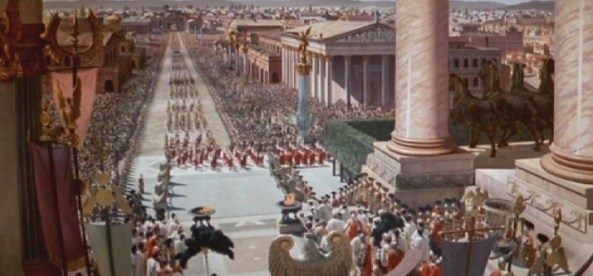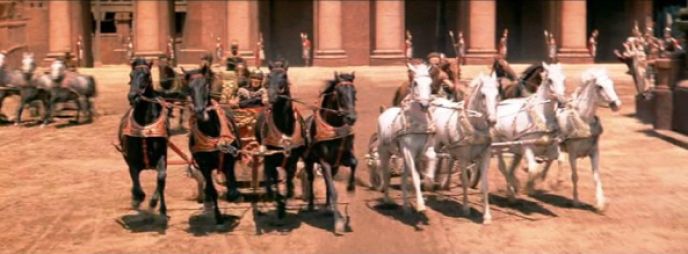Well scratch “Ben-Hur” from the list of super long movies I’ll eventually get around to seeing. I finally watched all 222 minutes of it. That just leaves “Intolerance,” “My Fair Lady” and “Giant” as 3-hour plus AFI 100 titles that will be buried in my Netflix queue for another few months or years.
But the reason you really have to watch “Ben-Hur” is because even today, watching it feels like an event. I rented it from the library on Blu-Ray because I decided, “This was the weekend I’m finally going to do it!” I was going to sit and listen to the six and a half minute Overture of unabashedly gigantic swells in Miklos Rosa’s score and just be wowed by something. I don’t think I felt that way when I popped “Persona” in the DVD player last week.
Here is a movie that shamelessly, un-cynically embraces its spirituality and its bigness. It lacks the nuance and adventure contained within something like “Lawrence of Arabia,” but in its straight-forward approach it attains that feeling of epic grandeur at every moment.
Director William Wyler ultimately agreed to do the project because he wanted to “Out DeMille Cecil B. DeMille.” “The Ten Commandments,” which also starred Charlton Heston, was a big success a few years earlier, but “Ben-Hur” was significant because it was the movie that would ultimately save MGM from bankruptcy (or at least until quite recently). The movie was the fastest money-maker of all time and was second only to “Gone With the Wind” at the box office.
You can see how it would catch on. Like “The Ten Commandments,” it reveled in Biblical drama, making Christ himself a key focal point of Judah Ben-Hur’s journey and the film’s climax, but it also matched the Bible’s reputation in sheer scale. Thousands of extras, over a million props and costumes, the largest movie set ever built; the sheer enormity of it was enough to warrant a sense of movie magic, even if “Ben-Hur” has not really aged as well as “Lawrence” has and William Wyler’s contribution to the film, as Andrew Sarris notes in “The American Cinema,” is ultimately impersonal.
What surprised me about the movie most of all is how talky it is. There are really only a handful of dynamic, busy set pieces, those being the early long slave walk through the desert, the test of the oarsman and their subsequent battle, and of course the famous chariot race, which we’ll get to later. The rest of the film operates on ideologies and bombast. There’s hilarious dialogue early on between Sextus and Mesalla (Stephen Boyd) about how there’s a guy named John (The Baptist) going around “drowning” people, which is a good example of how the discussion of religion is skeptical, but never dismissive. It never actually challenges the audience’s faith, even as we watch Judah suffer through slavery and heartbreak, then cringe at the thought of Judah’s mother and sister contracting leprosy.
In fact the dialogue is so straight-forward and without nuance that it would really be hard to believe were it not for Charlton Heston in the leading role. Heston is the perfect casting choice (although not the studio’s first choice) for such a film. Long a hammy, overblown actor, he here displays a constantly trembling face, quivering lips and droopy, unflattering eyes that make him appear as a man in turmoil, something that couldn’t be matched by Peter O’Toole’s confident sneer or Paul Newman’s modern good looks. Judah’s iconic bad-assedry then is established by Wyler’s trademark depth of field shots, foregrounding or back-grounding his silhouette in a dwarfing landscape or elaborate set.
What’s striking then about the famous chariot race is how different it looks from the firm, generally motionless camera that Wyler used to compensate for the wider aspect ratio. I learn from Wikipedia that the chariot sequence was in fact directed by Andrew Marton and Yakima Canutt, and that Wyler did not even have a look at the final cut. Again, the logistics of this sequence and the time it took to complete (over a year, for over $1 million) is a testament to the greatness of Old Hollywood, and yet the clever ideas contained within this scene are what make it so much more memorable from the rest of the film.
Cameras are placed at or below horse height, either following along side them to give the impression of horses bursting into the frame and taking the lead, or pointing directly toward them and demonstrating the combative nature of good versus evil, eight horses of black and white keeping pace and challenging for rank. Careening crane shots around the length of the track are stunts themselves, and the score is actually subtracted from this sequence to allow the excitement to palpitate on its own.
It’s the finest scene in the film by a mile, and it’s a magnificent start to “Ben-Hur’s” second part, which proves to be far greater than the first. Suddenly we begin to get a sense of revenge in the screenplay, not just tragedy, and the film’s mixed themes of family and religion begin to blend more seamlessly.
There’s a movie that just came out in theaters called “Oz The Great and Powerful” that people will now point to as an example of how Hollywood can no longer create spectacle in the same way they once did, and when pressed for an example of how the old studios used to create movie magic, it’s likely they’d point to “Ben-Hur.”
Let’s not forget though that “Ben-Hur” was largely responsible for the flux of epics that would continue to be jammed through the studio system until Old Hollywood finally died in 1967. It is at once an example of classical grandeur and ungainly excess. The dialogue has not aged well, and it does feel longer than it really should be. To watch it today is to see where Hollywood was at its best and worst.
Will Hollywood ever make another movie like “Ben-Hur?” In one way, no, they never could. In another, they probably never should. And a third way, have they ever stopped?

